Developing a Cross-Cultural Management Training Program for Opal-Mart
VerifiedAdded on 2019/10/30
|13
|3110
|202
Report
AI Summary
This report proposes a cross-cultural management training program tailored for Opal-Mart, addressing communication challenges among its diverse workforce of Chinese, Indian, and Australian employees. The program aims to overcome cultural barriers, reduce misunderstandings, and improve productivity by focusing on verbal and non-verbal communication differences, linguistic challenges, and cultural orientations. The training will include environmental briefings, cultural orientations, and cultural assimilators, delivered by experienced trainers with real-world business expertise. The program emphasizes relevance, real-world application, collaboration, and continuous learning, with a 14-day timeframe and post-training evaluation offering further support. The goal is to foster a more inclusive and productive work environment, increasing employee satisfaction and achieving the organization's vision. The training program provides a strategic plan to improve communication among workers of different backgrounds, focusing on their needs and providing evidence-based training to overcome barriers.
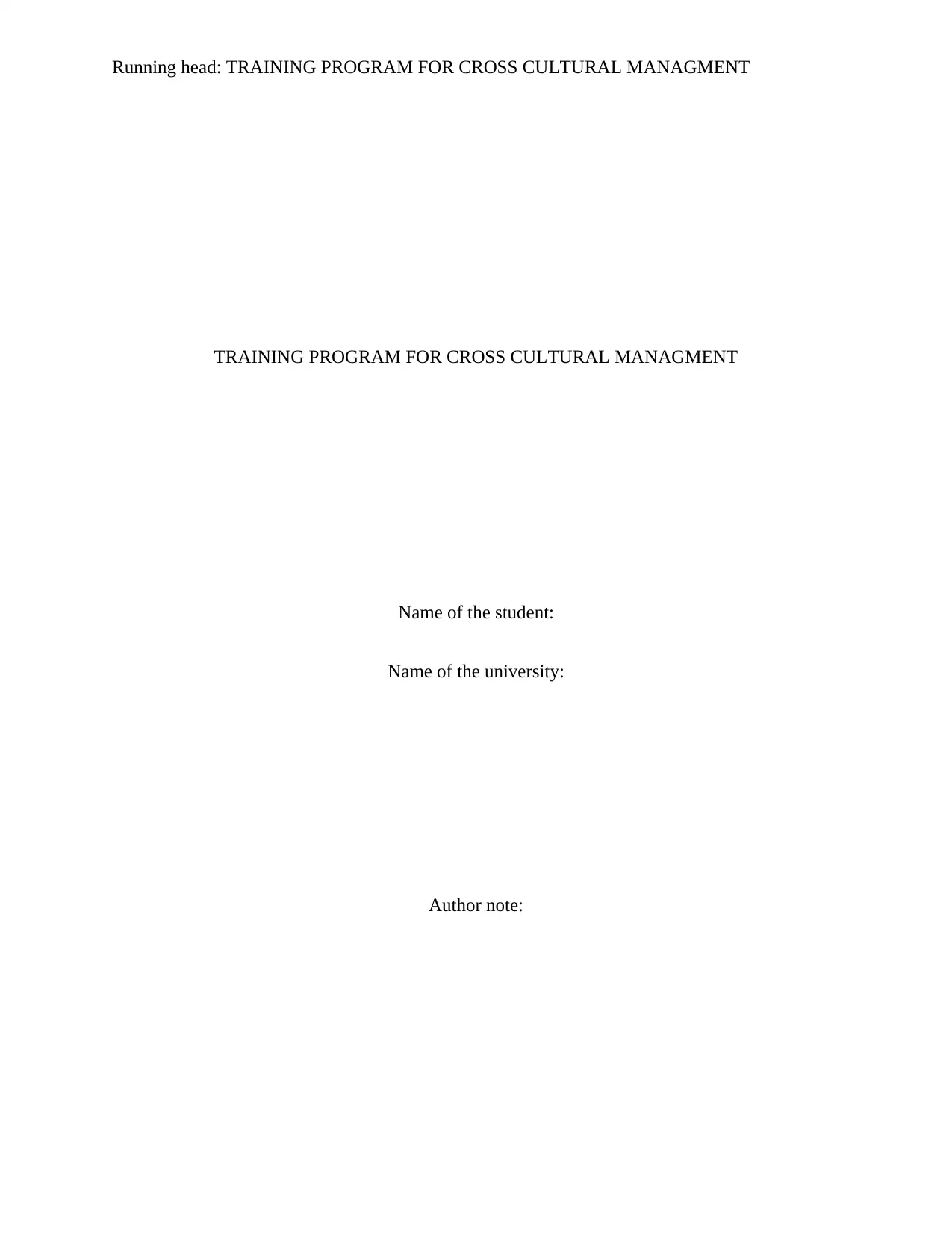
Running head: TRAINING PROGRAM FOR CROSS CULTURAL MANAGMENT
TRAINING PROGRAM FOR CROSS CULTURAL MANAGMENT
Name of the student:
Name of the university:
Author note:
TRAINING PROGRAM FOR CROSS CULTURAL MANAGMENT
Name of the student:
Name of the university:
Author note:
Paraphrase This Document
Need a fresh take? Get an instant paraphrase of this document with our AI Paraphraser
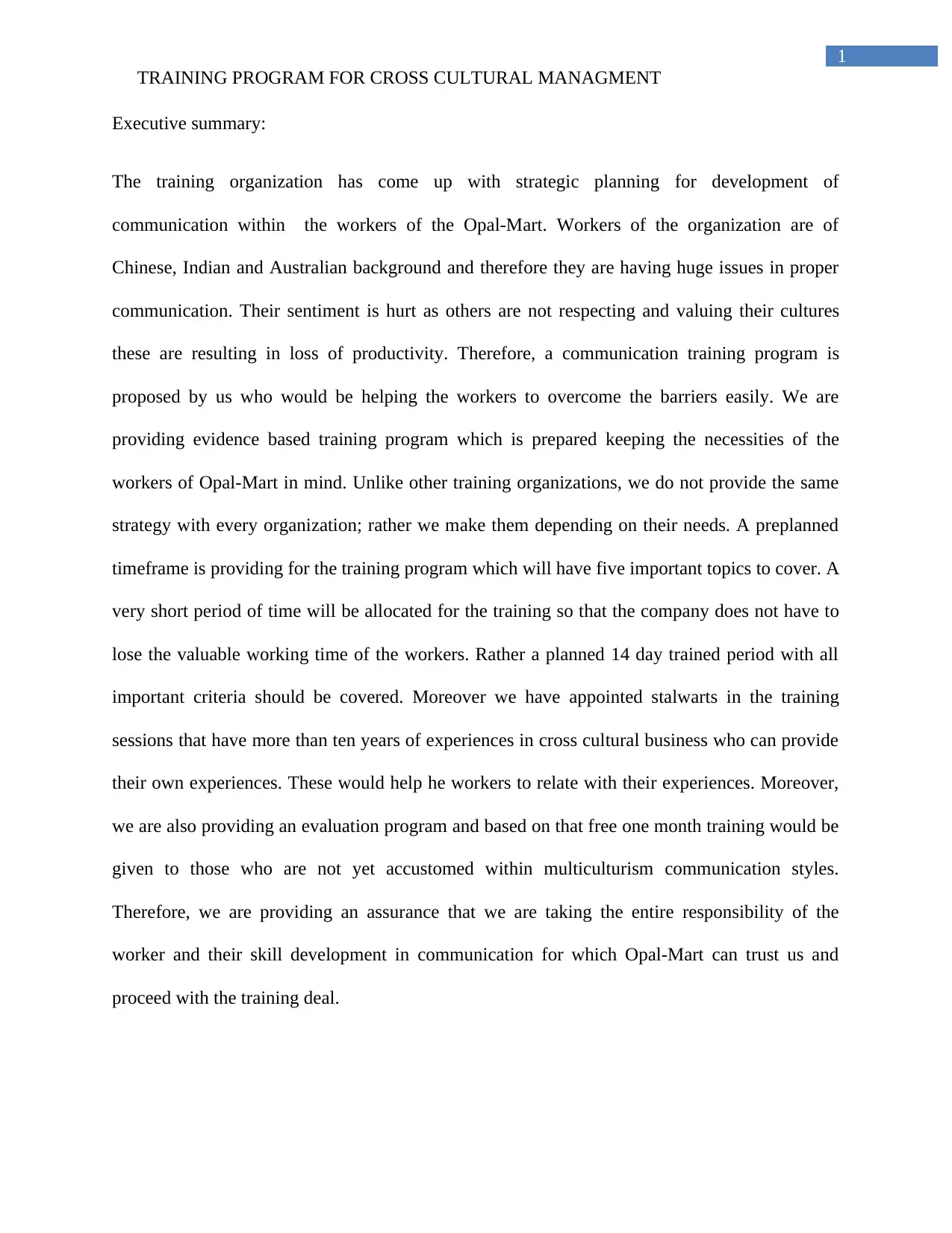
1
TRAINING PROGRAM FOR CROSS CULTURAL MANAGMENT
Executive summary:
The training organization has come up with strategic planning for development of
communication within the workers of the Opal-Mart. Workers of the organization are of
Chinese, Indian and Australian background and therefore they are having huge issues in proper
communication. Their sentiment is hurt as others are not respecting and valuing their cultures
these are resulting in loss of productivity. Therefore, a communication training program is
proposed by us who would be helping the workers to overcome the barriers easily. We are
providing evidence based training program which is prepared keeping the necessities of the
workers of Opal-Mart in mind. Unlike other training organizations, we do not provide the same
strategy with every organization; rather we make them depending on their needs. A preplanned
timeframe is providing for the training program which will have five important topics to cover. A
very short period of time will be allocated for the training so that the company does not have to
lose the valuable working time of the workers. Rather a planned 14 day trained period with all
important criteria should be covered. Moreover we have appointed stalwarts in the training
sessions that have more than ten years of experiences in cross cultural business who can provide
their own experiences. These would help he workers to relate with their experiences. Moreover,
we are also providing an evaluation program and based on that free one month training would be
given to those who are not yet accustomed within multiculturism communication styles.
Therefore, we are providing an assurance that we are taking the entire responsibility of the
worker and their skill development in communication for which Opal-Mart can trust us and
proceed with the training deal.
TRAINING PROGRAM FOR CROSS CULTURAL MANAGMENT
Executive summary:
The training organization has come up with strategic planning for development of
communication within the workers of the Opal-Mart. Workers of the organization are of
Chinese, Indian and Australian background and therefore they are having huge issues in proper
communication. Their sentiment is hurt as others are not respecting and valuing their cultures
these are resulting in loss of productivity. Therefore, a communication training program is
proposed by us who would be helping the workers to overcome the barriers easily. We are
providing evidence based training program which is prepared keeping the necessities of the
workers of Opal-Mart in mind. Unlike other training organizations, we do not provide the same
strategy with every organization; rather we make them depending on their needs. A preplanned
timeframe is providing for the training program which will have five important topics to cover. A
very short period of time will be allocated for the training so that the company does not have to
lose the valuable working time of the workers. Rather a planned 14 day trained period with all
important criteria should be covered. Moreover we have appointed stalwarts in the training
sessions that have more than ten years of experiences in cross cultural business who can provide
their own experiences. These would help he workers to relate with their experiences. Moreover,
we are also providing an evaluation program and based on that free one month training would be
given to those who are not yet accustomed within multiculturism communication styles.
Therefore, we are providing an assurance that we are taking the entire responsibility of the
worker and their skill development in communication for which Opal-Mart can trust us and
proceed with the training deal.
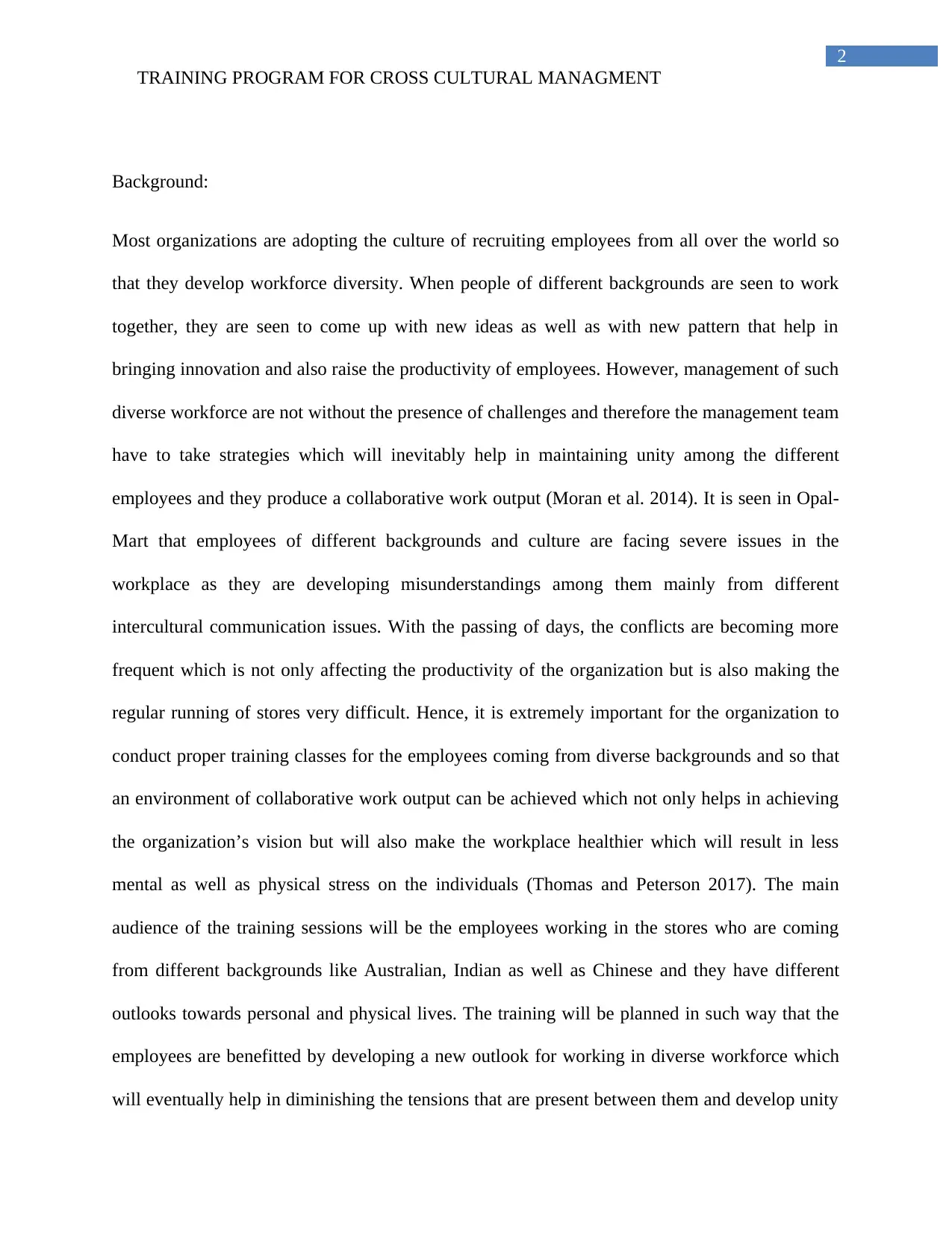
2
TRAINING PROGRAM FOR CROSS CULTURAL MANAGMENT
Background:
Most organizations are adopting the culture of recruiting employees from all over the world so
that they develop workforce diversity. When people of different backgrounds are seen to work
together, they are seen to come up with new ideas as well as with new pattern that help in
bringing innovation and also raise the productivity of employees. However, management of such
diverse workforce are not without the presence of challenges and therefore the management team
have to take strategies which will inevitably help in maintaining unity among the different
employees and they produce a collaborative work output (Moran et al. 2014). It is seen in Opal-
Mart that employees of different backgrounds and culture are facing severe issues in the
workplace as they are developing misunderstandings among them mainly from different
intercultural communication issues. With the passing of days, the conflicts are becoming more
frequent which is not only affecting the productivity of the organization but is also making the
regular running of stores very difficult. Hence, it is extremely important for the organization to
conduct proper training classes for the employees coming from diverse backgrounds and so that
an environment of collaborative work output can be achieved which not only helps in achieving
the organization’s vision but will also make the workplace healthier which will result in less
mental as well as physical stress on the individuals (Thomas and Peterson 2017). The main
audience of the training sessions will be the employees working in the stores who are coming
from different backgrounds like Australian, Indian as well as Chinese and they have different
outlooks towards personal and physical lives. The training will be planned in such way that the
employees are benefitted by developing a new outlook for working in diverse workforce which
will eventually help in diminishing the tensions that are present between them and develop unity
TRAINING PROGRAM FOR CROSS CULTURAL MANAGMENT
Background:
Most organizations are adopting the culture of recruiting employees from all over the world so
that they develop workforce diversity. When people of different backgrounds are seen to work
together, they are seen to come up with new ideas as well as with new pattern that help in
bringing innovation and also raise the productivity of employees. However, management of such
diverse workforce are not without the presence of challenges and therefore the management team
have to take strategies which will inevitably help in maintaining unity among the different
employees and they produce a collaborative work output (Moran et al. 2014). It is seen in Opal-
Mart that employees of different backgrounds and culture are facing severe issues in the
workplace as they are developing misunderstandings among them mainly from different
intercultural communication issues. With the passing of days, the conflicts are becoming more
frequent which is not only affecting the productivity of the organization but is also making the
regular running of stores very difficult. Hence, it is extremely important for the organization to
conduct proper training classes for the employees coming from diverse backgrounds and so that
an environment of collaborative work output can be achieved which not only helps in achieving
the organization’s vision but will also make the workplace healthier which will result in less
mental as well as physical stress on the individuals (Thomas and Peterson 2017). The main
audience of the training sessions will be the employees working in the stores who are coming
from different backgrounds like Australian, Indian as well as Chinese and they have different
outlooks towards personal and physical lives. The training will be planned in such way that the
employees are benefitted by developing a new outlook for working in diverse workforce which
will eventually help in diminishing the tensions that are present between them and develop unity
⊘ This is a preview!⊘
Do you want full access?
Subscribe today to unlock all pages.

Trusted by 1+ million students worldwide
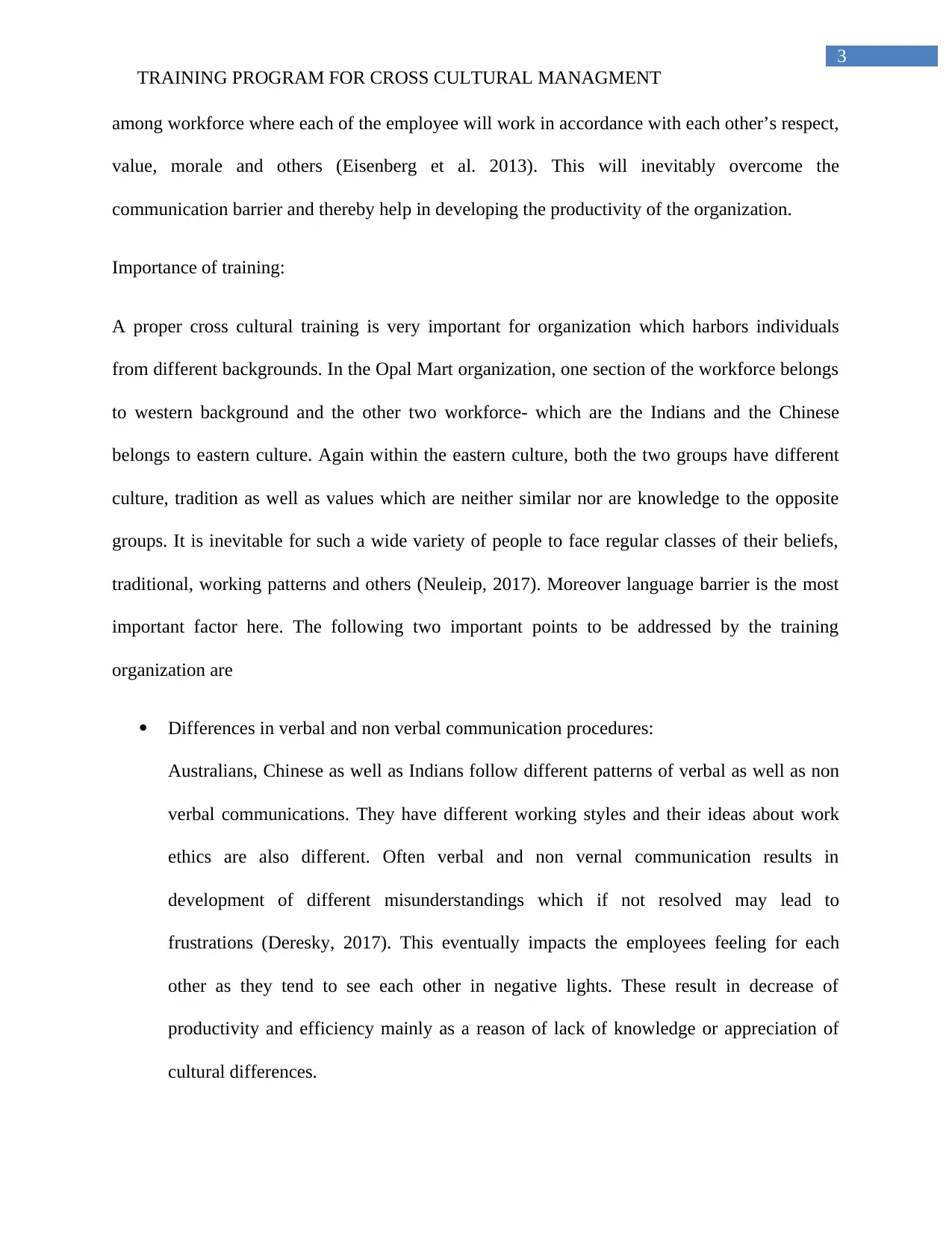
3
TRAINING PROGRAM FOR CROSS CULTURAL MANAGMENT
among workforce where each of the employee will work in accordance with each other’s respect,
value, morale and others (Eisenberg et al. 2013). This will inevitably overcome the
communication barrier and thereby help in developing the productivity of the organization.
Importance of training:
A proper cross cultural training is very important for organization which harbors individuals
from different backgrounds. In the Opal Mart organization, one section of the workforce belongs
to western background and the other two workforce- which are the Indians and the Chinese
belongs to eastern culture. Again within the eastern culture, both the two groups have different
culture, tradition as well as values which are neither similar nor are knowledge to the opposite
groups. It is inevitable for such a wide variety of people to face regular classes of their beliefs,
traditional, working patterns and others (Neuleip, 2017). Moreover language barrier is the most
important factor here. The following two important points to be addressed by the training
organization are
Differences in verbal and non verbal communication procedures:
Australians, Chinese as well as Indians follow different patterns of verbal as well as non
verbal communications. They have different working styles and their ideas about work
ethics are also different. Often verbal and non vernal communication results in
development of different misunderstandings which if not resolved may lead to
frustrations (Deresky, 2017). This eventually impacts the employees feeling for each
other as they tend to see each other in negative lights. These result in decrease of
productivity and efficiency mainly as a reason of lack of knowledge or appreciation of
cultural differences.
TRAINING PROGRAM FOR CROSS CULTURAL MANAGMENT
among workforce where each of the employee will work in accordance with each other’s respect,
value, morale and others (Eisenberg et al. 2013). This will inevitably overcome the
communication barrier and thereby help in developing the productivity of the organization.
Importance of training:
A proper cross cultural training is very important for organization which harbors individuals
from different backgrounds. In the Opal Mart organization, one section of the workforce belongs
to western background and the other two workforce- which are the Indians and the Chinese
belongs to eastern culture. Again within the eastern culture, both the two groups have different
culture, tradition as well as values which are neither similar nor are knowledge to the opposite
groups. It is inevitable for such a wide variety of people to face regular classes of their beliefs,
traditional, working patterns and others (Neuleip, 2017). Moreover language barrier is the most
important factor here. The following two important points to be addressed by the training
organization are
Differences in verbal and non verbal communication procedures:
Australians, Chinese as well as Indians follow different patterns of verbal as well as non
verbal communications. They have different working styles and their ideas about work
ethics are also different. Often verbal and non vernal communication results in
development of different misunderstandings which if not resolved may lead to
frustrations (Deresky, 2017). This eventually impacts the employees feeling for each
other as they tend to see each other in negative lights. These result in decrease of
productivity and efficiency mainly as a reason of lack of knowledge or appreciation of
cultural differences.
Paraphrase This Document
Need a fresh take? Get an instant paraphrase of this document with our AI Paraphraser
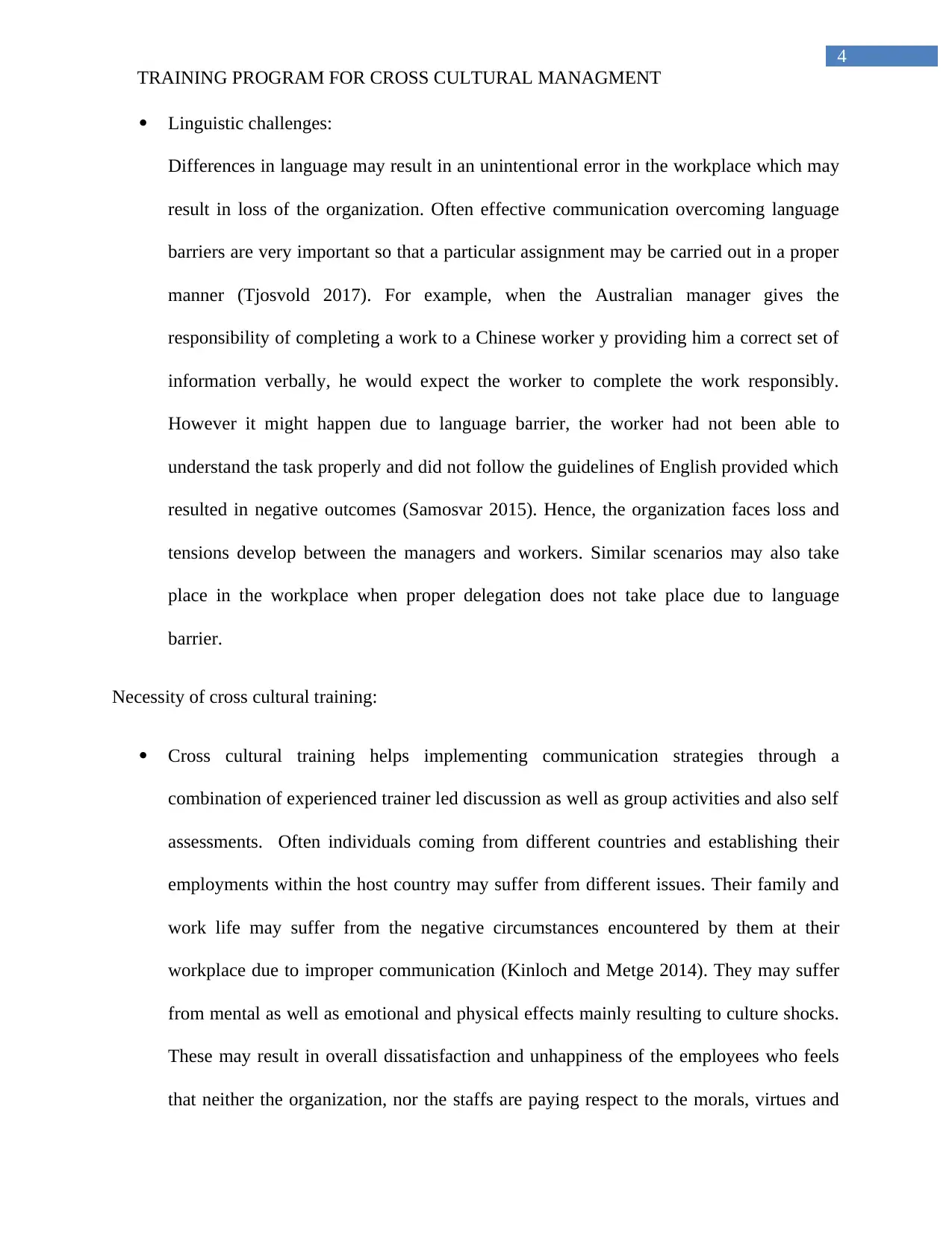
4
TRAINING PROGRAM FOR CROSS CULTURAL MANAGMENT
Linguistic challenges:
Differences in language may result in an unintentional error in the workplace which may
result in loss of the organization. Often effective communication overcoming language
barriers are very important so that a particular assignment may be carried out in a proper
manner (Tjosvold 2017). For example, when the Australian manager gives the
responsibility of completing a work to a Chinese worker y providing him a correct set of
information verbally, he would expect the worker to complete the work responsibly.
However it might happen due to language barrier, the worker had not been able to
understand the task properly and did not follow the guidelines of English provided which
resulted in negative outcomes (Samosvar 2015). Hence, the organization faces loss and
tensions develop between the managers and workers. Similar scenarios may also take
place in the workplace when proper delegation does not take place due to language
barrier.
Necessity of cross cultural training:
Cross cultural training helps implementing communication strategies through a
combination of experienced trainer led discussion as well as group activities and also self
assessments. Often individuals coming from different countries and establishing their
employments within the host country may suffer from different issues. Their family and
work life may suffer from the negative circumstances encountered by them at their
workplace due to improper communication (Kinloch and Metge 2014). They may suffer
from mental as well as emotional and physical effects mainly resulting to culture shocks.
These may result in overall dissatisfaction and unhappiness of the employees who feels
that neither the organization, nor the staffs are paying respect to the morals, virtues and
TRAINING PROGRAM FOR CROSS CULTURAL MANAGMENT
Linguistic challenges:
Differences in language may result in an unintentional error in the workplace which may
result in loss of the organization. Often effective communication overcoming language
barriers are very important so that a particular assignment may be carried out in a proper
manner (Tjosvold 2017). For example, when the Australian manager gives the
responsibility of completing a work to a Chinese worker y providing him a correct set of
information verbally, he would expect the worker to complete the work responsibly.
However it might happen due to language barrier, the worker had not been able to
understand the task properly and did not follow the guidelines of English provided which
resulted in negative outcomes (Samosvar 2015). Hence, the organization faces loss and
tensions develop between the managers and workers. Similar scenarios may also take
place in the workplace when proper delegation does not take place due to language
barrier.
Necessity of cross cultural training:
Cross cultural training helps implementing communication strategies through a
combination of experienced trainer led discussion as well as group activities and also self
assessments. Often individuals coming from different countries and establishing their
employments within the host country may suffer from different issues. Their family and
work life may suffer from the negative circumstances encountered by them at their
workplace due to improper communication (Kinloch and Metge 2014). They may suffer
from mental as well as emotional and physical effects mainly resulting to culture shocks.
These may result in overall dissatisfaction and unhappiness of the employees who feels
that neither the organization, nor the staffs are paying respect to the morals, virtues and
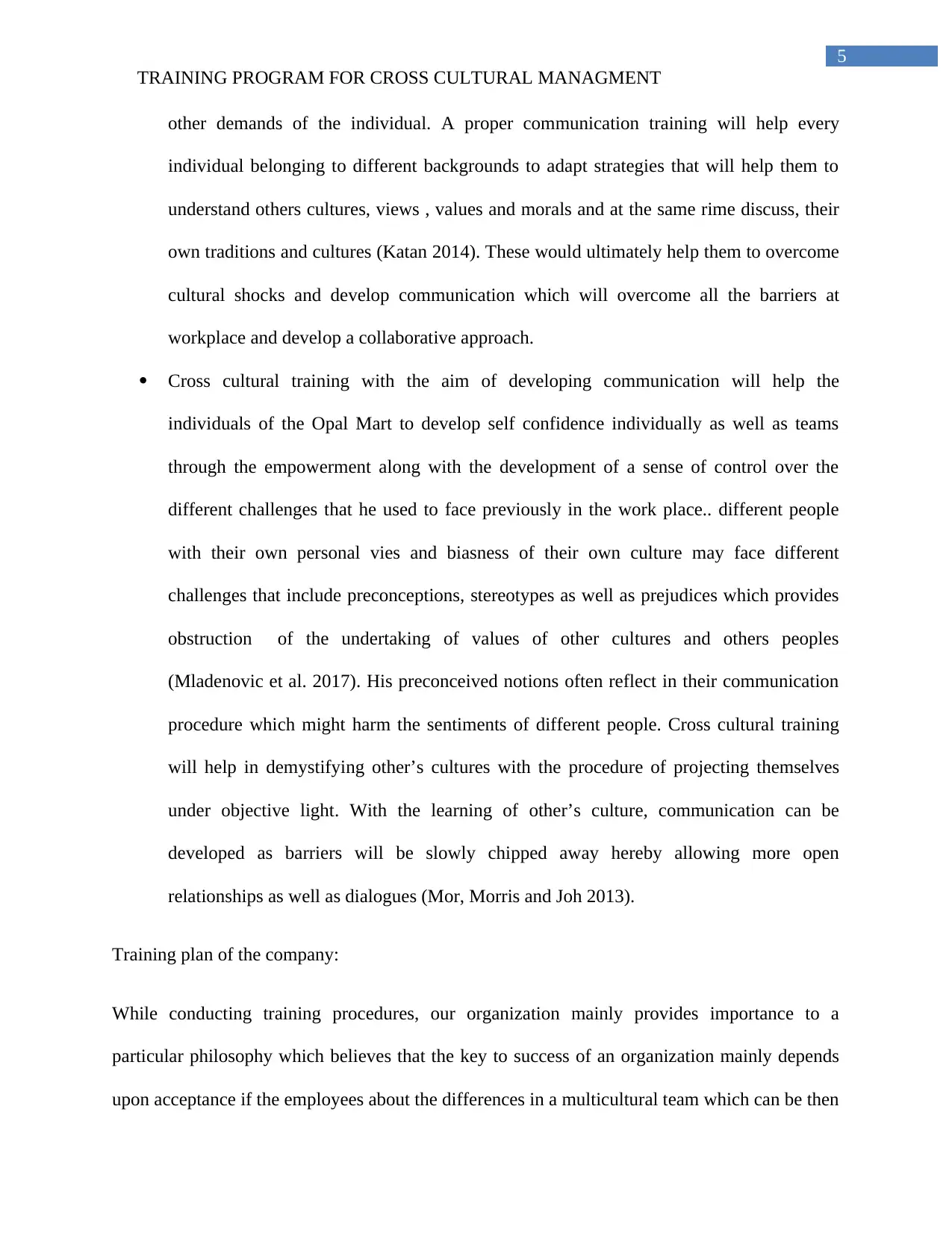
5
TRAINING PROGRAM FOR CROSS CULTURAL MANAGMENT
other demands of the individual. A proper communication training will help every
individual belonging to different backgrounds to adapt strategies that will help them to
understand others cultures, views , values and morals and at the same rime discuss, their
own traditions and cultures (Katan 2014). These would ultimately help them to overcome
cultural shocks and develop communication which will overcome all the barriers at
workplace and develop a collaborative approach.
Cross cultural training with the aim of developing communication will help the
individuals of the Opal Mart to develop self confidence individually as well as teams
through the empowerment along with the development of a sense of control over the
different challenges that he used to face previously in the work place.. different people
with their own personal vies and biasness of their own culture may face different
challenges that include preconceptions, stereotypes as well as prejudices which provides
obstruction of the undertaking of values of other cultures and others peoples
(Mladenovic et al. 2017). His preconceived notions often reflect in their communication
procedure which might harm the sentiments of different people. Cross cultural training
will help in demystifying other’s cultures with the procedure of projecting themselves
under objective light. With the learning of other’s culture, communication can be
developed as barriers will be slowly chipped away hereby allowing more open
relationships as well as dialogues (Mor, Morris and Joh 2013).
Training plan of the company:
While conducting training procedures, our organization mainly provides importance to a
particular philosophy which believes that the key to success of an organization mainly depends
upon acceptance if the employees about the differences in a multicultural team which can be then
TRAINING PROGRAM FOR CROSS CULTURAL MANAGMENT
other demands of the individual. A proper communication training will help every
individual belonging to different backgrounds to adapt strategies that will help them to
understand others cultures, views , values and morals and at the same rime discuss, their
own traditions and cultures (Katan 2014). These would ultimately help them to overcome
cultural shocks and develop communication which will overcome all the barriers at
workplace and develop a collaborative approach.
Cross cultural training with the aim of developing communication will help the
individuals of the Opal Mart to develop self confidence individually as well as teams
through the empowerment along with the development of a sense of control over the
different challenges that he used to face previously in the work place.. different people
with their own personal vies and biasness of their own culture may face different
challenges that include preconceptions, stereotypes as well as prejudices which provides
obstruction of the undertaking of values of other cultures and others peoples
(Mladenovic et al. 2017). His preconceived notions often reflect in their communication
procedure which might harm the sentiments of different people. Cross cultural training
will help in demystifying other’s cultures with the procedure of projecting themselves
under objective light. With the learning of other’s culture, communication can be
developed as barriers will be slowly chipped away hereby allowing more open
relationships as well as dialogues (Mor, Morris and Joh 2013).
Training plan of the company:
While conducting training procedures, our organization mainly provides importance to a
particular philosophy which believes that the key to success of an organization mainly depends
upon acceptance if the employees about the differences in a multicultural team which can be then
⊘ This is a preview!⊘
Do you want full access?
Subscribe today to unlock all pages.

Trusted by 1+ million students worldwide
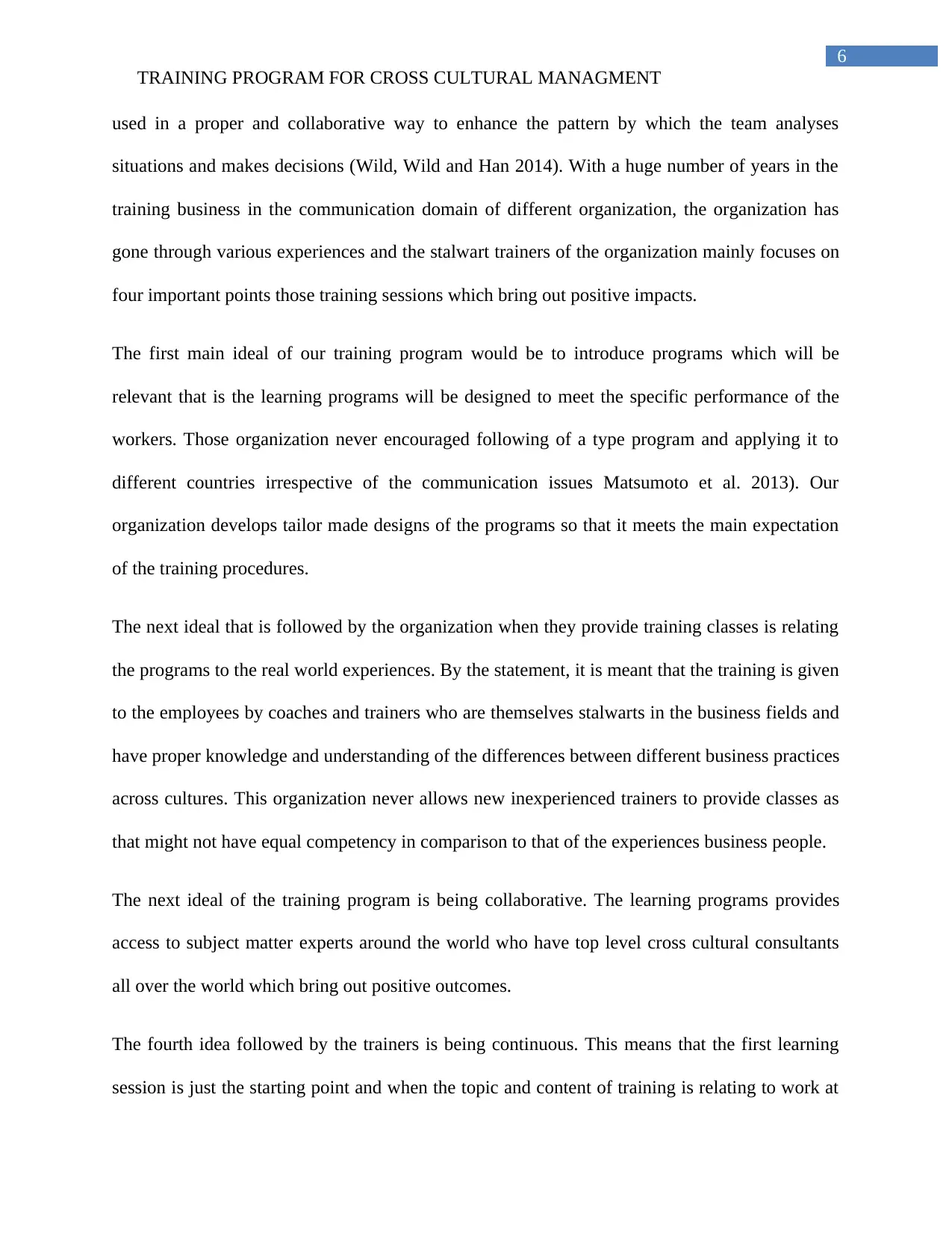
6
TRAINING PROGRAM FOR CROSS CULTURAL MANAGMENT
used in a proper and collaborative way to enhance the pattern by which the team analyses
situations and makes decisions (Wild, Wild and Han 2014). With a huge number of years in the
training business in the communication domain of different organization, the organization has
gone through various experiences and the stalwart trainers of the organization mainly focuses on
four important points those training sessions which bring out positive impacts.
The first main ideal of our training program would be to introduce programs which will be
relevant that is the learning programs will be designed to meet the specific performance of the
workers. Those organization never encouraged following of a type program and applying it to
different countries irrespective of the communication issues Matsumoto et al. 2013). Our
organization develops tailor made designs of the programs so that it meets the main expectation
of the training procedures.
The next ideal that is followed by the organization when they provide training classes is relating
the programs to the real world experiences. By the statement, it is meant that the training is given
to the employees by coaches and trainers who are themselves stalwarts in the business fields and
have proper knowledge and understanding of the differences between different business practices
across cultures. This organization never allows new inexperienced trainers to provide classes as
that might not have equal competency in comparison to that of the experiences business people.
The next ideal of the training program is being collaborative. The learning programs provides
access to subject matter experts around the world who have top level cross cultural consultants
all over the world which bring out positive outcomes.
The fourth idea followed by the trainers is being continuous. This means that the first learning
session is just the starting point and when the topic and content of training is relating to work at
TRAINING PROGRAM FOR CROSS CULTURAL MANAGMENT
used in a proper and collaborative way to enhance the pattern by which the team analyses
situations and makes decisions (Wild, Wild and Han 2014). With a huge number of years in the
training business in the communication domain of different organization, the organization has
gone through various experiences and the stalwart trainers of the organization mainly focuses on
four important points those training sessions which bring out positive impacts.
The first main ideal of our training program would be to introduce programs which will be
relevant that is the learning programs will be designed to meet the specific performance of the
workers. Those organization never encouraged following of a type program and applying it to
different countries irrespective of the communication issues Matsumoto et al. 2013). Our
organization develops tailor made designs of the programs so that it meets the main expectation
of the training procedures.
The next ideal that is followed by the organization when they provide training classes is relating
the programs to the real world experiences. By the statement, it is meant that the training is given
to the employees by coaches and trainers who are themselves stalwarts in the business fields and
have proper knowledge and understanding of the differences between different business practices
across cultures. This organization never allows new inexperienced trainers to provide classes as
that might not have equal competency in comparison to that of the experiences business people.
The next ideal of the training program is being collaborative. The learning programs provides
access to subject matter experts around the world who have top level cross cultural consultants
all over the world which bring out positive outcomes.
The fourth idea followed by the trainers is being continuous. This means that the first learning
session is just the starting point and when the topic and content of training is relating to work at
Paraphrase This Document
Need a fresh take? Get an instant paraphrase of this document with our AI Paraphraser
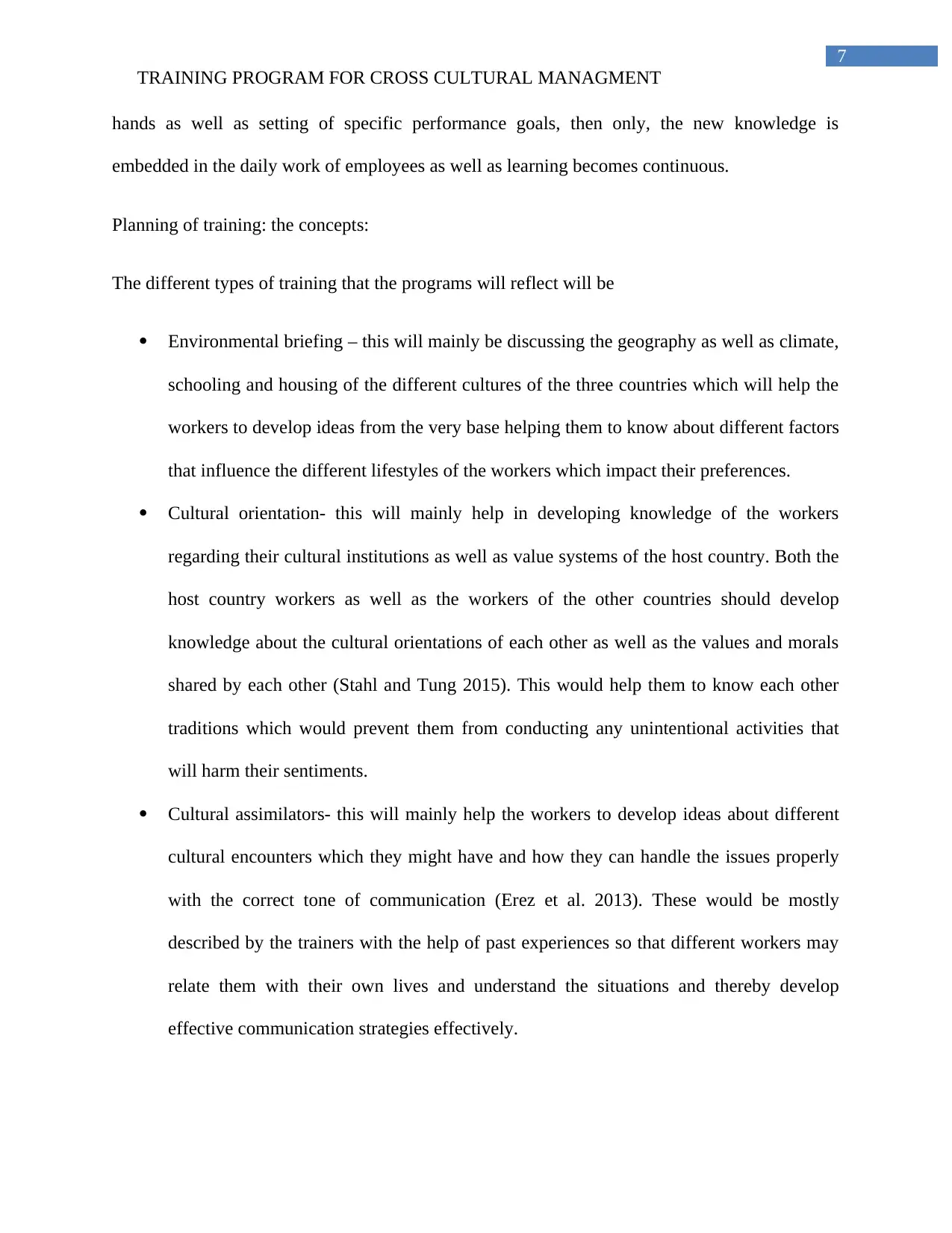
7
TRAINING PROGRAM FOR CROSS CULTURAL MANAGMENT
hands as well as setting of specific performance goals, then only, the new knowledge is
embedded in the daily work of employees as well as learning becomes continuous.
Planning of training: the concepts:
The different types of training that the programs will reflect will be
Environmental briefing – this will mainly be discussing the geography as well as climate,
schooling and housing of the different cultures of the three countries which will help the
workers to develop ideas from the very base helping them to know about different factors
that influence the different lifestyles of the workers which impact their preferences.
Cultural orientation- this will mainly help in developing knowledge of the workers
regarding their cultural institutions as well as value systems of the host country. Both the
host country workers as well as the workers of the other countries should develop
knowledge about the cultural orientations of each other as well as the values and morals
shared by each other (Stahl and Tung 2015). This would help them to know each other
traditions which would prevent them from conducting any unintentional activities that
will harm their sentiments.
Cultural assimilators- this will mainly help the workers to develop ideas about different
cultural encounters which they might have and how they can handle the issues properly
with the correct tone of communication (Erez et al. 2013). These would be mostly
described by the trainers with the help of past experiences so that different workers may
relate them with their own lives and understand the situations and thereby develop
effective communication strategies effectively.
TRAINING PROGRAM FOR CROSS CULTURAL MANAGMENT
hands as well as setting of specific performance goals, then only, the new knowledge is
embedded in the daily work of employees as well as learning becomes continuous.
Planning of training: the concepts:
The different types of training that the programs will reflect will be
Environmental briefing – this will mainly be discussing the geography as well as climate,
schooling and housing of the different cultures of the three countries which will help the
workers to develop ideas from the very base helping them to know about different factors
that influence the different lifestyles of the workers which impact their preferences.
Cultural orientation- this will mainly help in developing knowledge of the workers
regarding their cultural institutions as well as value systems of the host country. Both the
host country workers as well as the workers of the other countries should develop
knowledge about the cultural orientations of each other as well as the values and morals
shared by each other (Stahl and Tung 2015). This would help them to know each other
traditions which would prevent them from conducting any unintentional activities that
will harm their sentiments.
Cultural assimilators- this will mainly help the workers to develop ideas about different
cultural encounters which they might have and how they can handle the issues properly
with the correct tone of communication (Erez et al. 2013). These would be mostly
described by the trainers with the help of past experiences so that different workers may
relate them with their own lives and understand the situations and thereby develop
effective communication strategies effectively.
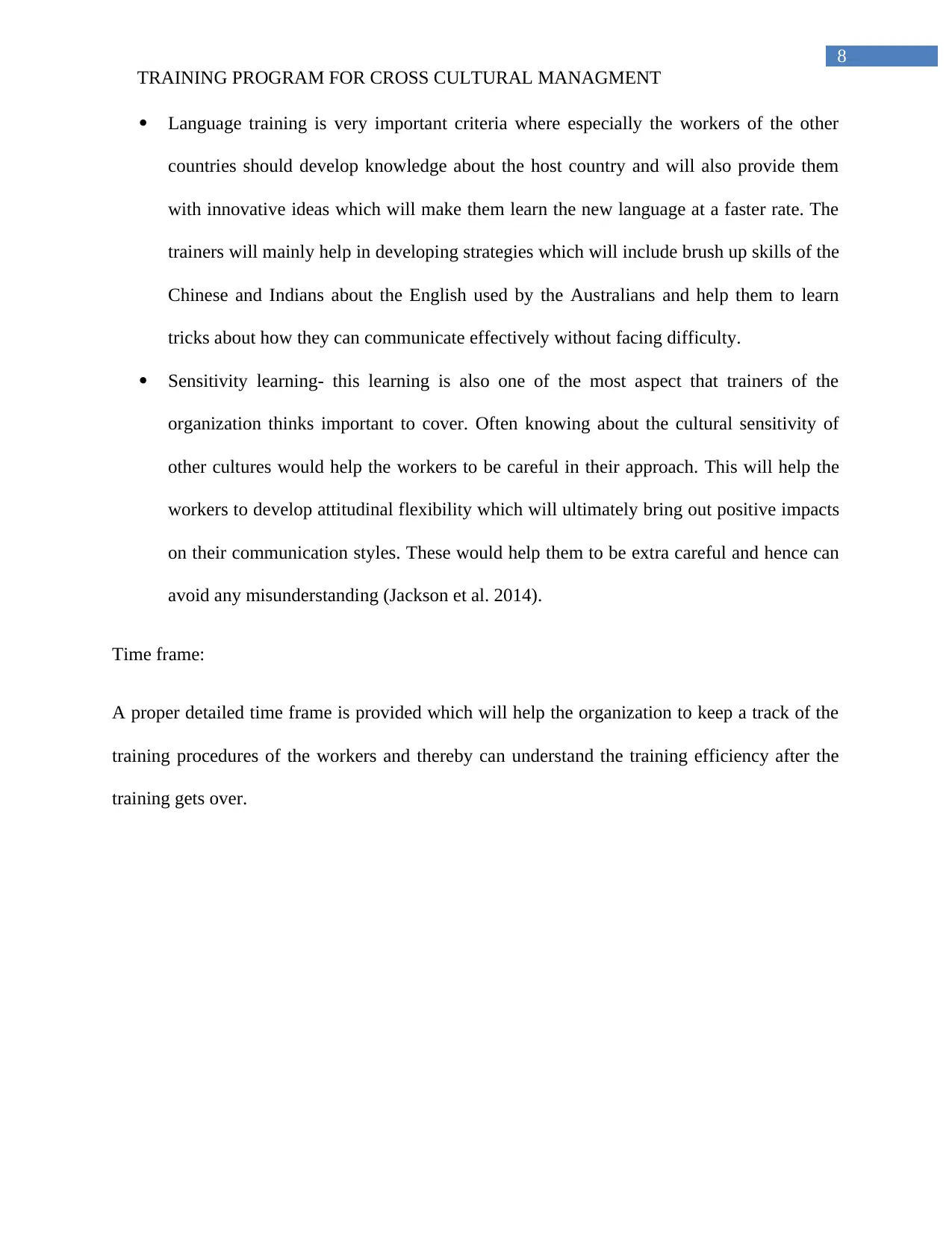
8
TRAINING PROGRAM FOR CROSS CULTURAL MANAGMENT
Language training is very important criteria where especially the workers of the other
countries should develop knowledge about the host country and will also provide them
with innovative ideas which will make them learn the new language at a faster rate. The
trainers will mainly help in developing strategies which will include brush up skills of the
Chinese and Indians about the English used by the Australians and help them to learn
tricks about how they can communicate effectively without facing difficulty.
Sensitivity learning- this learning is also one of the most aspect that trainers of the
organization thinks important to cover. Often knowing about the cultural sensitivity of
other cultures would help the workers to be careful in their approach. This will help the
workers to develop attitudinal flexibility which will ultimately bring out positive impacts
on their communication styles. These would help them to be extra careful and hence can
avoid any misunderstanding (Jackson et al. 2014).
Time frame:
A proper detailed time frame is provided which will help the organization to keep a track of the
training procedures of the workers and thereby can understand the training efficiency after the
training gets over.
TRAINING PROGRAM FOR CROSS CULTURAL MANAGMENT
Language training is very important criteria where especially the workers of the other
countries should develop knowledge about the host country and will also provide them
with innovative ideas which will make them learn the new language at a faster rate. The
trainers will mainly help in developing strategies which will include brush up skills of the
Chinese and Indians about the English used by the Australians and help them to learn
tricks about how they can communicate effectively without facing difficulty.
Sensitivity learning- this learning is also one of the most aspect that trainers of the
organization thinks important to cover. Often knowing about the cultural sensitivity of
other cultures would help the workers to be careful in their approach. This will help the
workers to develop attitudinal flexibility which will ultimately bring out positive impacts
on their communication styles. These would help them to be extra careful and hence can
avoid any misunderstanding (Jackson et al. 2014).
Time frame:
A proper detailed time frame is provided which will help the organization to keep a track of the
training procedures of the workers and thereby can understand the training efficiency after the
training gets over.
⊘ This is a preview!⊘
Do you want full access?
Subscribe today to unlock all pages.

Trusted by 1+ million students worldwide
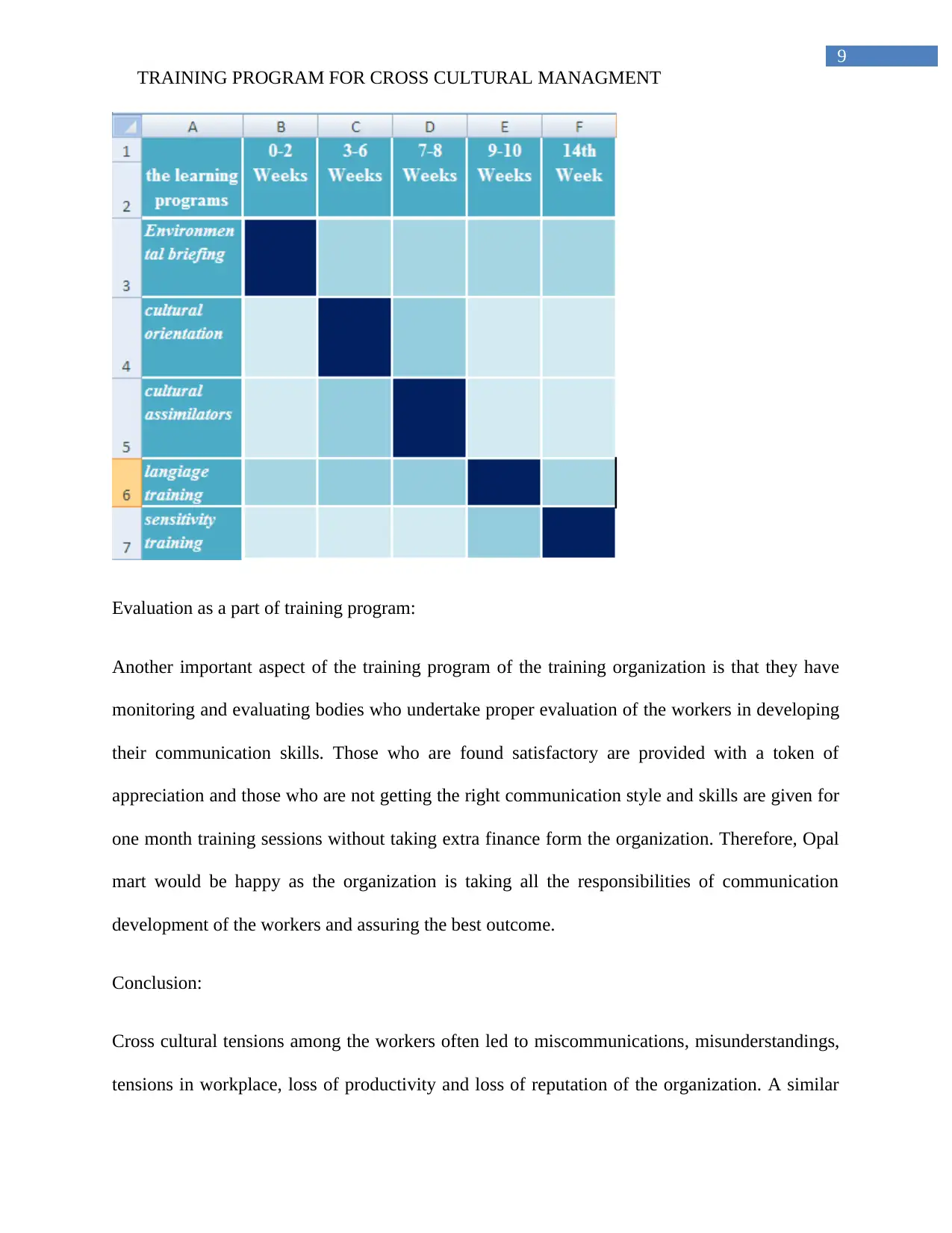
9
TRAINING PROGRAM FOR CROSS CULTURAL MANAGMENT
Evaluation as a part of training program:
Another important aspect of the training program of the training organization is that they have
monitoring and evaluating bodies who undertake proper evaluation of the workers in developing
their communication skills. Those who are found satisfactory are provided with a token of
appreciation and those who are not getting the right communication style and skills are given for
one month training sessions without taking extra finance form the organization. Therefore, Opal
mart would be happy as the organization is taking all the responsibilities of communication
development of the workers and assuring the best outcome.
Conclusion:
Cross cultural tensions among the workers often led to miscommunications, misunderstandings,
tensions in workplace, loss of productivity and loss of reputation of the organization. A similar
TRAINING PROGRAM FOR CROSS CULTURAL MANAGMENT
Evaluation as a part of training program:
Another important aspect of the training program of the training organization is that they have
monitoring and evaluating bodies who undertake proper evaluation of the workers in developing
their communication skills. Those who are found satisfactory are provided with a token of
appreciation and those who are not getting the right communication style and skills are given for
one month training sessions without taking extra finance form the organization. Therefore, Opal
mart would be happy as the organization is taking all the responsibilities of communication
development of the workers and assuring the best outcome.
Conclusion:
Cross cultural tensions among the workers often led to miscommunications, misunderstandings,
tensions in workplace, loss of productivity and loss of reputation of the organization. A similar
Paraphrase This Document
Need a fresh take? Get an instant paraphrase of this document with our AI Paraphraser
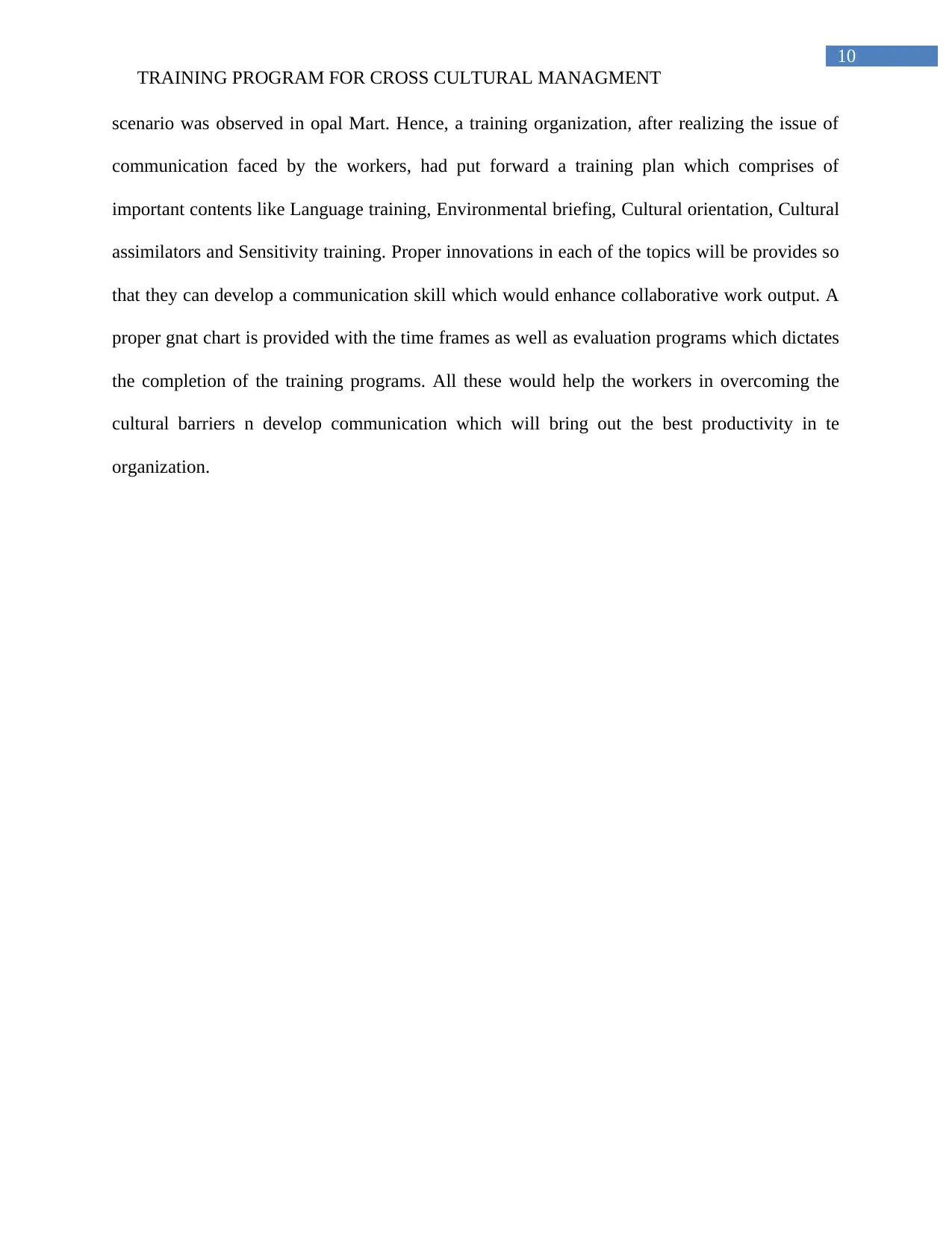
10
TRAINING PROGRAM FOR CROSS CULTURAL MANAGMENT
scenario was observed in opal Mart. Hence, a training organization, after realizing the issue of
communication faced by the workers, had put forward a training plan which comprises of
important contents like Language training, Environmental briefing, Cultural orientation, Cultural
assimilators and Sensitivity training. Proper innovations in each of the topics will be provides so
that they can develop a communication skill which would enhance collaborative work output. A
proper gnat chart is provided with the time frames as well as evaluation programs which dictates
the completion of the training programs. All these would help the workers in overcoming the
cultural barriers n develop communication which will bring out the best productivity in te
organization.
TRAINING PROGRAM FOR CROSS CULTURAL MANAGMENT
scenario was observed in opal Mart. Hence, a training organization, after realizing the issue of
communication faced by the workers, had put forward a training plan which comprises of
important contents like Language training, Environmental briefing, Cultural orientation, Cultural
assimilators and Sensitivity training. Proper innovations in each of the topics will be provides so
that they can develop a communication skill which would enhance collaborative work output. A
proper gnat chart is provided with the time frames as well as evaluation programs which dictates
the completion of the training programs. All these would help the workers in overcoming the
cultural barriers n develop communication which will bring out the best productivity in te
organization.
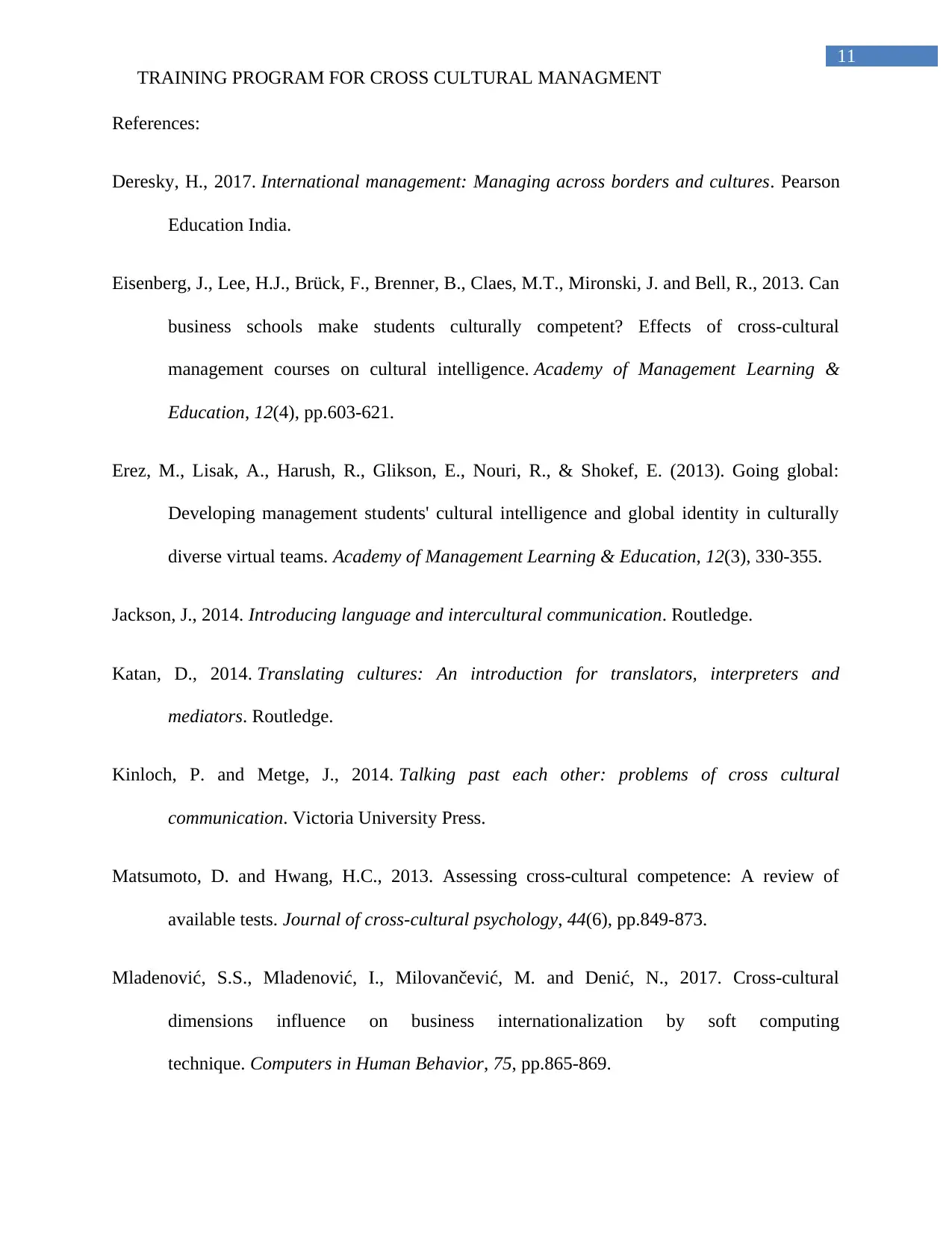
11
TRAINING PROGRAM FOR CROSS CULTURAL MANAGMENT
References:
Deresky, H., 2017. International management: Managing across borders and cultures. Pearson
Education India.
Eisenberg, J., Lee, H.J., Brück, F., Brenner, B., Claes, M.T., Mironski, J. and Bell, R., 2013. Can
business schools make students culturally competent? Effects of cross-cultural
management courses on cultural intelligence. Academy of Management Learning &
Education, 12(4), pp.603-621.
Erez, M., Lisak, A., Harush, R., Glikson, E., Nouri, R., & Shokef, E. (2013). Going global:
Developing management students' cultural intelligence and global identity in culturally
diverse virtual teams. Academy of Management Learning & Education, 12(3), 330-355.
Jackson, J., 2014. Introducing language and intercultural communication. Routledge.
Katan, D., 2014. Translating cultures: An introduction for translators, interpreters and
mediators. Routledge.
Kinloch, P. and Metge, J., 2014. Talking past each other: problems of cross cultural
communication. Victoria University Press.
Matsumoto, D. and Hwang, H.C., 2013. Assessing cross-cultural competence: A review of
available tests. Journal of cross-cultural psychology, 44(6), pp.849-873.
Mladenović, S.S., Mladenović, I., Milovančević, M. and Denić, N., 2017. Cross-cultural
dimensions influence on business internationalization by soft computing
technique. Computers in Human Behavior, 75, pp.865-869.
TRAINING PROGRAM FOR CROSS CULTURAL MANAGMENT
References:
Deresky, H., 2017. International management: Managing across borders and cultures. Pearson
Education India.
Eisenberg, J., Lee, H.J., Brück, F., Brenner, B., Claes, M.T., Mironski, J. and Bell, R., 2013. Can
business schools make students culturally competent? Effects of cross-cultural
management courses on cultural intelligence. Academy of Management Learning &
Education, 12(4), pp.603-621.
Erez, M., Lisak, A., Harush, R., Glikson, E., Nouri, R., & Shokef, E. (2013). Going global:
Developing management students' cultural intelligence and global identity in culturally
diverse virtual teams. Academy of Management Learning & Education, 12(3), 330-355.
Jackson, J., 2014. Introducing language and intercultural communication. Routledge.
Katan, D., 2014. Translating cultures: An introduction for translators, interpreters and
mediators. Routledge.
Kinloch, P. and Metge, J., 2014. Talking past each other: problems of cross cultural
communication. Victoria University Press.
Matsumoto, D. and Hwang, H.C., 2013. Assessing cross-cultural competence: A review of
available tests. Journal of cross-cultural psychology, 44(6), pp.849-873.
Mladenović, S.S., Mladenović, I., Milovančević, M. and Denić, N., 2017. Cross-cultural
dimensions influence on business internationalization by soft computing
technique. Computers in Human Behavior, 75, pp.865-869.
⊘ This is a preview!⊘
Do you want full access?
Subscribe today to unlock all pages.

Trusted by 1+ million students worldwide
1 out of 13
Related Documents
Your All-in-One AI-Powered Toolkit for Academic Success.
+13062052269
info@desklib.com
Available 24*7 on WhatsApp / Email
![[object Object]](/_next/static/media/star-bottom.7253800d.svg)
Unlock your academic potential
Copyright © 2020–2025 A2Z Services. All Rights Reserved. Developed and managed by ZUCOL.




